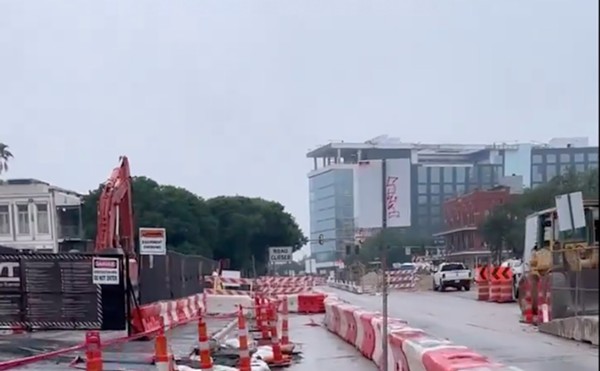Calvin Tillman set out on his weekend tour across South Texas hoping to alert area landowners about the dark side of the growing oil shale boom. Beginning at a Laredo forum packed with local farmers, environmental activists, and industry reps, Tillman worked his way northeast from the Rio Grande, crossing a region teeming with drilling rigs.
Tillman, who saw firsthand the Barnett Shale’s own drilling explosion as the mayor of Dish, cautioned locals bracing for the drilling frenzy bubbling in South Texas’ oil- and gas-rich Eagle Ford Shale, claiming lax state regulation cleared the way for air and water contamination that plagues his small North Texas town. Tillman warned, “You’ve probably heard and you’ll probably hear again that what happened [elsewhere] will not happen here. That’s what we heard.”
To the Laredo crowd, Tillman remarked, “I’m not opposed to natural gas drilling, I’m not some wacko environmentalist … I am against being poisoned, though, and I’m certainly against my children being poisoned.”
Heralded as a game-changer for the South Texas economy, industry is flocking to the Eagle Ford, one of North America’s hottest petroleum plays. Since its discovery, permits have exploded from only 26 in 2008 to nearly 1,000 within the first four months of this year, according figures from the Texas Railroad Commission, which regulates the industry. A recent study claims as many as 100,000 natural gas wells could dot the South Texas landscape when all’s said and done.
Stretching across roughly 400 miles of hot, dry terrain, the Eagle Ford currently sustains roughly 12,000 jobs across a 24-county swath of South Texas and under “moderate” projections could support nearly 70,000 full-time jobs within the coming decade, according to researchers with the University of Texas at San Antonio’s Institute of Economic Development.
But concerns over water contamination and damaging health effects have followed the drilling process, known as hydraulic fracturing or fracking, nearly everywhere industry takes it. From the Northeast to the Southwest, critics have charged the method, which injects massive amounts of chemical-infused water thousands of feet underground to break up oil- and gas-bearing shale, taints local groundwater, though industry and regulators here claim it’s a geologic impossibility. And suffering through one of Texas’ worst drought in recorded history, observers wonder how to balance scarcity with a lucrative industry that requires massive amounts of increasingly precious water to operate.
On his trip, Tillman brought with him a vial of ashy gray sediment, which he said came from a groundwater well just 500 feet from a natural gas production site in his North Texas hometown. The water, when tested, showed high levels of arsenic, lead, bentonite, and benzene, compounds common in fracking fluid, also known as drilling mud. Tillman ties the contamination of that well, and several North Texas wells like it, to nearby fracking, though regulators dispute the claim.
Sharon Wilson, an environmental activist who documents complaints of contamination across North Texas for the non profit organization Earthworks, accompanied Tillman on his trip across the Eagle Ford, and said, “What happened in the Barnett Shale? We had very rapid development. They move in and they move in fast. … This is not the same kind of drilling that your grandparents experienced in West Texas.”
For years, industry has insisted that the fracking process is safe and hasn’t been linked to any instances of contaminated groundwater.
But a laundry list of cases test that claim. In Garfield County, Colo., a three-year study detailed methane seepage into water supplies as a result of fracking. Cabot Oil & Gas, a Texas-based company, settled out of court with locals in Dimock, Pa., who complained of contaminated wells and a blowout that shot toxic chemicals into nearby waterways.
Closer to home, Wilson claims 70 percent of Dish residents surveyed complain of respiratory problems since oil and gas moved next door, and researchers have noted “astoundingly high” formaldehyde levels in the Barnett Shale area linked to natural gas exploration — levels high enough to exacerbate that area’s ground-level ozone problem.
The Environmental Protection Agency in December ordered gas company Range Resources to quickly fix methane contamination problems in North Texas’ Parker County, where residents complained of flammable and bubbling drinking water flowing from the tap. Tests showed the presence of cancer-causing benzene and “extremely high levels” of methane, posing an “imminent and substantial risk of explosion or fire.” EPA investigators linked the contamination to nearby natural gas drilling.
In March, the RRC cleared the company of all liability, saying nearby well-water drillers had simply penetrated a shallow natural gas field. “We’re still at a place [in Texas] where we’re trying to sort out what’s really going on here,” said Charles Groat, director of the Center for International Energy and Environmental Policy at UT Austin who’s leading a comprehensive nine-month study of the fracking process.
“There have been a lot of counter-claims by industry saying, ‘Well, it couldn’t possibly be fracking,’” Groat said. “There clearly are documented problems with shale-gas development. Is it the fracking process? Is it the casing? Is it disposal fluid handling? What is it? … Right now it’s too early to tell.”
Groat plans to roll out preliminary findings from the study, which will look at water and air contamination as well as claims of fracking-related earthquakes, by the end of 2011, he said.
With the recent signing of Texas’ House Bill 3328, the RRC will next year lay out requirements for companies to disclose the toxic chemicals they inject into the ground. Still, environmentalists fear the measure, arguably one of the broadest of its kind, falls short by failing to demand companies reveal all chemicals used, including proprietary recipes exempted from disclosure. Elizabeth Ames Jones, RRC chairwoman, told Bloomberg News early this month, “We won’t be knowing the recipes. That’s sacred ground as far as I’m concerned.”
Because of staffing levels and a spotty track record of enforcement, critics worry the RRC is poorly positioned to respond to the concerns that arise with increased fracking in the Eagle Ford — including the disposal of toxic fracking mud and ensuring proper well casing to prevent blowouts.
The state’s Sunset Review this session slammed the commission, saying it fails to stem industry abuses because it rarely fines or even cites violators, and both Tillman and Wilson claimed unaddressed problems in the Barnett Shale have proven the commission lacks the teeth to properly regulate the industry. “I don’t want you guys thinking the Railroad Commission will be your savior,” Tillman told the Laredo crowd. “They’re not going to come down here and protect you from this happening.”
The RRC oversees 48 employees out of its San Antonio and Corpus Christi field offices, which respond to the Eagle Ford region. In total, only 16 field inspectors cover the whole of South Texas, according to RRC records — a paltry number, Wilson said, given the expected spike in production in the coming years.
“About 10 years ago the RRC had about 730 oil and gas employees. Now we have about 320 … and the volume of activity has only increased,” said Gil Bujano, deputy director of the RRC’s oil and gas division. Acknowledging the RRC’s understaffing, Bujano said, “If we’ve got elected officials who come in and say they want to downsize government and cut our employees, well there are repercussions there.”
Toby Frederick, who lives outside Cuero in DeWitt County, another piece of the Eagle Ford buzzing with oil and gas exploration, claimed the RRC fumbled his case when his well water began to reek of diesel fuel last summer.
Frederick quickly contacted the commission for testing soon after his water took on a noxious odor. After the commission tested the water in September, 2010, found nothing wrong, and insisted a toxicologist had deemed the water safe, Frederick and his family continued cooking and bathing with water from the well. “That smell never went away,” Frederick said. “I eventually paid for a private test. … I guess I wasn’t shocked we found all this stuff in it. That smell will make you dizzy.”
Independent testing found half a dozen benzene compounds in Frederick’s water above EPA contamination levels, he said, and an RRC inspector’s report Frederick later obtained dating back to September shows benzene contamination was suspected all along. Frederick didn’t stop using the water until April, 2011.
Frederick has since spent $6,000 drilling another shallower well to supply water for his house but still can’t pinpoint what caused the initial contamination.
The well sits 60 feet away from a capped, decades-old natural gas well, which Frederick suspects could have corroded and breached. He also points to a natural gas compression station down the road, the breach of a nearby open air pit for containing used drilling fluids, and two nearby fracking wells that blew their casings in recent years. “I don’t blame gas drilling. ... I don’t know what caused it,” he said. “But I do want the Railroad Commission to figure out what happened,” he said, fearing other nearby wells could face contamination if the problem continues unabated.
Parrying claims of water contamination and a dysfunctional regulatory agency, Bujano claimed the Eagle Ford can’t be compared to other shale formations, including the Barnett. Companies in the Eagle Ford, he said, typically drill to a depth of up to 12,000 feet, deeper than the average Barnett Shale well which runs somewhere between 6,000 and 8,000 feet deep. The deep drilling leaves a huge spread between the oil-bearing shale and usable groundwater wells — usually 4,000 to 6,000 feet in Karnes County, for instance. “Some folks believe that a frack, that pathway, is severe enough, powerful enough, to reach your usable quality water zone … and what I’m telling you is that it’s not,” he said.
While Wilson and others dispute that claim, another factor that separates the Eagle Ford from shale formations elsewhere is the massive amount of water needed to frack each well. Robert Mace, an administrator with the Texas Water Development Board, said fracking in the Eagle Ford is water-intensive, requiring up to 13 million gallons of water per well, compared to just 4 million in the Barnett Shale.
“It just requires more water to get it to crack,” Mace said, and, given scarce surface water in South Texas, “a lot of these companies are looking at groundwater.” Further drought conditions could push companies to rely on more water bought from irrigation districts and local farmers, he said.
The Railroad Commission, which failed to return several email and phone requests for comment, is planning to roll out a water-recycling program for companies fracking in the Eagle Ford, though details about it are not readily available.
A spokesman with Anadarko Petroleum Corp., a Houston-based company that has announced plans to up its Eagle Ford presence in the coming year, said the company is installing metering devices on its wells that draw from the southwestern Carrizo-Wilcox aquifer. “We have not seen any significant declines in the overall water level of the aquifer and the drought conditions have not affected our operations,” said Brian Cain.
The company, he said, also works with the Wintergarden Groundwater Conservation District, sharing pumping data to help monitor water levels and usage there.
Early this year, Karnes County residents claimed increased water demand for oil and gas drilling may have already begun to pump water tables dry there, and the nearby Evergreen Underground Water Conservation District began monitoring wells when landowners launched complaints that industry pumping had lowered water tables in the shallow “water sands.”
Next door in DeWitt County, Mark Krueger, who tests local well water for common bacteria, claimed a local man called him regarding water contamination. “He said, ‘I’ve got kidney problems,’ then he says, ‘My kids throw up after every shower.’” Krueger said he found high levels of iron bacteria that continued even after repeated treatments, and suspects other chemicals taint the water. “I mean, to me, that shows the problem isn’t isolated; this indicated that the entire aquifer stone that man was drawing from could be contaminated,” Krueger said.
Krueger said he notified Pecan Valley Groundwater Conservation District, suspecting increased water draws for nearby fracking may have caused a severe cone of depression that reversed water flow.
Pecan Valley last month commissioned a study hoping to determine how the rapid increase in groundwater pumping has impacted the local water table, said Charlotte Krause, the district’s general manager. In the past, the district would receive about two reports a year of wells running dry. “We’ve had 15 just within the last month,” Krause said.
The typical DeWitt County rancher may pull about 20 gallons a minute from the Gulf Coast aquifer, Krause said, adding, “Now you’ve got companies pulling up to 400 gallons a minute.” Krause has also been trying to gather concrete water-use figures from local companies, though not all have been forthcoming, she said.
A study set to be released later this summer by the Texas Water Development Board and the University of Texas’ Bureau of Economic Geology estimates that Texas water used in fracking was negligible in 2010, but that the demand for water to frack the Eagle Ford will likely spike ten-fold to over 6.5 billion gallons per year by 2020. Demand will then double again by 2030, the study estimates.
David Marquez, executive director of Bexar County’s economic development department, said, “The challenges here are obvious. You just have to drive through this part of the country and see there aren’t broad rivers or springs.” Industry groups, he said, have already begun to realize the same process used in other shale formations “can’t just be flopped down into the Eagle Ford,” and water-recycling programs will likely be required to keep the water flowing. •
See also:
Sinking feelings
Gas fracking may already be lowering water tables in South Texas
http://www2.sacurrent.com/news/story.asp?id=71891
Warming trend
Regulators far from ready for challenges fracking brings to South Texas
http://www2.sacurrent.com/news/story.asp?id=71968


















